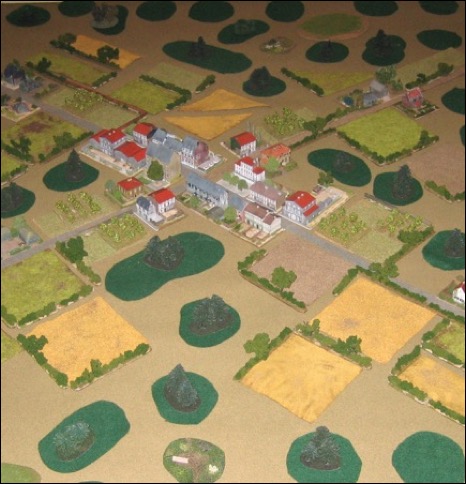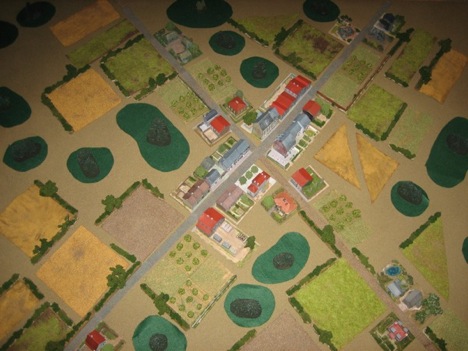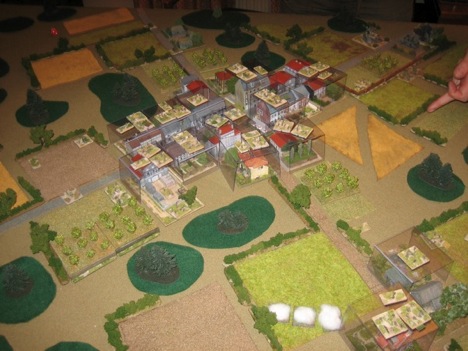Lloyd Nikolas’s crossroads scenario.
Introduction
This game is based on Lloyd’s crossroads game. This is detailed on:
http://www.lloydianaspects.co.uk/wargames/crossfire/cfxroad.html
The board

View of the village from the W. The British attack from the N (left), Germans from the S (right).

Top view of the board. N is at the top of the image.
The board is dominated by a village at a crossroads, with the roads forming an X across the board. At the crossroads there is a damaged/destroyed vehicle that blocks sight (we used a Panther). The village is surrounded by dense terrain. The aim of the game is to hold three of the four village quadrants at the game end.
Order of battle
British
- Leg Infantry Company 1 - Morale: Veteran, CC, 3" mortar + FO, HMG, 3 × Platoon, 1 in three sections with PIAT
- Leg Infantry Company 1 - Morale: Veteran, CC, 3" mortar + FO, HMG, 3 × Platoon, 1 in three sections with PIAT
- Armour: 4 × Churchill VII, 4 × Sherman; 4 × Cromwell VII
- Support: 2 × 6 pdr ATG + truck
German
- Leg Infantry Company 1 - Morale: Regulars, CC, 81 mm mortar + FO, HMG, 3 × Platoon, all squads with panzerfaust.
- Leg Infantry Company 2 - Morale: Regulars, CC, 81 mm mortar + FO, HMG, 3 × Platoon, all squads with panzerfaust.
- Leg Infantry Company 3 - Morale: Regulars, CC, 81 mm mortar + FO, HMG, 2 × Platoon, all squads with panzerfaust.
- Armour: 1 × StuG IIIG, 1 × PzKw IVH, 1 × PzKw V, 1 × Hetzer
- Support: 4 × SdKfz 251D, 2 × SdKfz 251C9.
Briefing notes for players
The Allies are advancing out of Normandy, just after Operation Bluecoat. The Germans have withdrawn, regrouped, and are now ready to counter-attack. Both sides are advancing towards the important crossroads of Saint-Toby-le-Noir, vital for both side’s communication and resupply. It must be captured.
To win
The objective is either to defeat the enemy, or to take and hold the majority of the buildings in the village.
To win, a player must occupy buildings of at least three of the four sections of village.
The clock
Each time the Geman side ends its initiative, a die is rolled to see how much time has passed, and the clock is advanced half an hour on a 4+. The game starts at 10 am, and darkness falls at 2100 hours.
Deployment phase
Players alternate either:
- Deploying one vehicle or platoon or platoon with attached assets (such as HMGs and vehicles) at a time along the broad edges.
- A single (possibly group) move of unit on the table (i.e. if you are moving a squad only, then it may pivot and move, no more).
Contact!
Once contact is announced, the two players roll to see who has initiative.
Reinforcements
Any units off-table when contact occurs count as reinforcements. They may only be brought onto the table along the long edge during a player’s initiative.
During one initiative players may deploy:
- Multiple vehicles of one vehicle type
- All or part of a company (which can have attached vehicles and other assets)
House rules
Stout buildings (Lloyd’s rule)
“A couple of major buildings in the village are half-way between hardpoints and ordinary buildings.
Firing at these involves throwing one extra die and ignoring the highest result of all the dice. For example, rifles firing at a building would normally roll 2 dice. Instead, when firing at these buildings, they roll three dice, and get 5, 5, 3. One five, being one of the highest numbers, is ignored, so a pin, not a suppress, is the result. The probability of a suppress by this method is about half-way between the stats. for a hardpoint (6s needed), and a normal building.”
Direct HE fire at buildings
Direct HE fire at normal buildings does not suffer the usual 1D6 less penalty. Direct HE fire at a stout building uses a penalty die (see above).
Vehicles
- Up to one vehicle per squad plus 1 may be attached to a platoon.
- Vehicles may group move with the PC and squads of the platoon, but retain the restriction of only one move or main gun shot per initiative.
- If a vehicle is firing its machine guns only, it may crossfire with the platoon, but the PC must be within one base width. Only one vehicle may crossfire with the platoon. A vehicle may perform multiple machine gun attacks in an initiative, but if it does so it may not move or fire its main gun.
- A vehicle firing HE from its main gun does not lose initiative if it misses (we did this to encourage the use of HE fire by tanks - in previous games, without this rule, there was very little support fire from tanks).
The game
I umpired the game for two friends, relative newcomers to Crossfire. In hindsight, this scenario is a bit complicated for people unfamiliar with the rules (and I play infrequently, so am a bit rusty), especially as it involves the use of a lot of troops and armour.
The deployment phase worked well, but did take a long time as the players agonised over where to deploy, and when to call “Contact!”. In the end both advanced into the village, with limited flank cover, and took up positions within the buildings. They only declared contact when they had occupied most of the buildings and had troops peeking at each other across the street.
The resulting game consisted of two main battles: a battle of attrition in the village, and sweeping flanking moves (especially by the British).
On the flanks the British were able to race round the German rear and take out their self-propelled guns by close assault, preventing them from supporting the German infantry in the village. The Germans also made some headway on the flanks, primarily by using smoke to isolate pockets of British and then close assaulting them.
However the key action was in the village, where the British gradually wore down the Germans by sustained fire. We didn’t play to completion, but it was clear that the Germans had lost and that it was only a matter of time before the British held the whole village.

The fight in the village. (I use plastic ‘hats’ so that the models can be supported over buildings when buildings are occupied).
Questions arising
How close to your own troops can you call in indirect fire ? Our decision was that the target had to be further away than the total length of smoke the weapon could lay.
Debrief
It was a fun game - many thanks to Lloyd for coming up with the idea!
The deployment phase worked well and proved very challenging to players.
I think experienced players would have played the game differently. A couple of platoons (with attached HMGs) deployed on each flank, spread amongst the terrain but with good crossfires, would have been a good idea.
It also takes quite a time for a new player to realise how mobile you can be in Crossfire; I don’t think either player made the most of their opportunities.
The best news is that both players enjoyed the game and want to play again soon, but with fewer troops next time!

